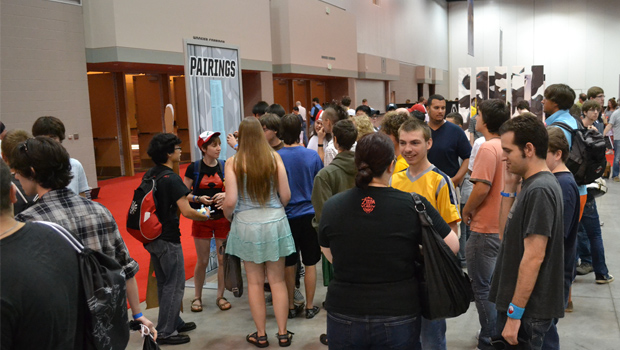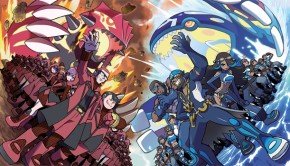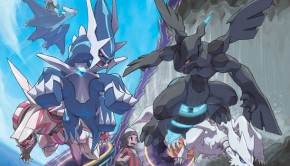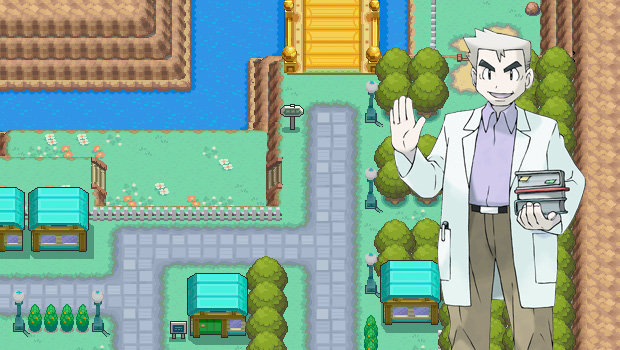The 2013 North American VGC Circuit and You: What’s Changed and What That Means
In case you weren’t online yesterday, Nugget Bridge Headquarters was inundated with a veritable flood of news stories, which flesh out the remainder of the North American VGC Series for the 2013 season. There’s a lot to unpack, so bear with me as I attempt to make sense of the changes and highlight their impact on the circuit as a whole. Note that the opinions contained within are entirely my own and not representative of Nugget Bridge as a whole, and I look forward to discussing them with you in the comments.
There are four main updates to last year’s format in the categories of prizes, WiFi tournaments, Championship Points, and the North American Nationals format. Let’s take a look at the headlines:
Prizes Increase Across the Board… Except for Third and Fourth Place Masters Finishers
TPCI raised a bit of a stir at the beginning of the season when they announced a net prize decrease for the Autumn Regionals. Most notably, only the top two finishers in the Masters division received any prize money — a travel award for the Champion and a $300 travel stipend for the runner-up — instead of the $300 stipend going to the top 4 as had been the case in all previous Regionals. Juniors and Seniors likewise saw a small prize decrease to $500 for second through fourth place finishers, down from $600 in the past.
Fortunately, TPCI has heard and responded, upping the prize to Masters finalists to $600 and $750 to Juniors and Seniors finalists with third and fourth place in the Seniors division receiving $700. This represents an increase across the board for every placement that would have scored you a prize in 2011… except for third and fourth place masters finishers who will still receive nothing.
TPCI has stated in the past that Juniors and Seniors receive more prize support because that is where the money is: if they can get players hooked young, they’ll have them for life. While this may be true, and I’m not fully convinced it is, it is also detrimental to the long-term competitive health of the game. While Seniors has become a dramatically more competitive division since its inception in 2011, the Masters division remains the heart of competitive Pokémon and the division that TPCI should be most focused on growing if it hopes to create the perception of Pokémon as a competitive game.
The greatest motivator is self-interest, and more talented players will come from farther away to compete for better prizes. Increasing the prize to the Regionals runner-up is a step in the right direction, but I’m still disheartened to see prizes for top four in the Masters division go by the wayside. When you limit prizes, you also limit the amount of people who believe they can win those prizes. Relatively few people enter a Regional thinking they can take the Championship; more enter thinking they can place in the top four (and so on, and so on). At some point you have to step back and decide where the cut-off is — you can’t give prizes to everyone — but top four has historically been TPCI’s cut-off and continues to be TPCI’s cut-off for Juniors and Seniors.
Still, the prize increase is much appreciated, especially at the National level. The North American National Championships have been probably the most competitive and difficult tournaments of the VGC season for at least the past few years with an incredibly deep pool of talented and strong trainers; they deserve to be rewarded handsomely. While I’m very disappointed that Worlds invites weren’t extended to at least the top eight, more on that later, adding a Nintendo 3DS to the prize pool of second through fourth place and a 32GB Deluxe Nintendo Wii U to the Champion in addition to fully-paid trips to Vancouver for all four is a more than welcome change. I’m very pleased to see additions to the prize pool here and expect them to make North American Nationals an even more difficult tournament.
WiFi Tournaments to Count for Championship Points and Regionals Byes… But Will Your Battles Count?
WiFi Tournaments have, in the past, been a fun diversion worth only bragging rights. That all changes this year with the announcement that last year’s “Friendlies” are now “Challenges” worth Championship Points and advantages in your Regional. However, given previous tournaments’ history of disconnections, it’s unclear how accurate the rankings will be. To combat this, TPCI has used both the carrot and the stick: offering a Custap Berry to any player who completes ten matches and is not disqualified and threatening to disqualify players found to be in violation of their disconnection policy from future WiFi tournaments. There is also a concern that these tournaments disadvantage those without access to Nintendo DS approved WiFi, like yours truly, or who are unable to commit to the extreme amount of time required to climb the online ladder in a weekend.
I’m cautiously optimistic for this change. In general, it’s a good thing for the community to have more tournaments that actually mean something. The Friendlies were fun, but at the end of the day, you couldn’t take them very seriously because they were only worth bragging rights. As I mentioned in the previous section, self-interest is a great motivator and an advantage at increasingly competitive Regionals and Championship Points towards a Worlds invite are both in my self-interest. Still, for these tournaments to be taken seriously, there has to be a dramatic reduction in disconnections or accurate punishment for those found to be maliciously disconnecting on their opponents, preferably both. I can’t stress enough how important it is to make sure that the leaderboard at the end of the tournament, and thus the recipients of byes and Championship Points, accurately reflects the top 16 and top 128 of that tournament and not merely those who were able to disconnect “strategically.” The upcoming 2013 VGCS Winter Battle (registration open now!) will be a crucial test of the integrity of the WiFi system. If TPCI is able to pull this one off, I will declare adding WiFi to the VGC circuit an unqualified success.
I’m not particularly concerned about the secondary issues of lack of access to Nintendo DS approved WiFi, though I don’t currently have it, or the time constraints. The former can usually be rectified at most coffee shops or by asking your parents to change your wireless router’s security settings, while the latter is a secondary complaint to me. I fully understand and appreciate the concerns — top of the ladder won’t be the best, merely the people with the most time to kill, for example — but compare them to a Regional. I, at least, spent a little over two days, total, traveling or competing in the Philadelphia Regional. It’s not something I can make time for every weekend, but these WiFi tournaments will not be occurring every weekend. Further, the prizes aren’t so significant that you will need to spend every waking moment playing Pokémon for a shot at some monstrous prize package. The most significant prize here are the Championship Points, which… Well. Let’s just go right into that one:
Championship Points Pave the Path to Worlds… But For How Many?
Currently, we know that Championship Points will be used as an alternate path to Worlds if you are unable to place in the top four of North American Nationals, and presumably whatever European equivalent is announced. We also know the Championship Point breakdown for both North America Regional and National Championships. The top 128 in upcoming WiFi Tournaments will also receive Championship Points. Aaaaand that’s about it.
Questions left to answer: How many Championship Points will the top 128 in WiFi Tournaments receive? How many players will receive Worlds invites based on their Championship Points? Will invites given to players who have already secured an invite to Worlds like the top four from Nationals pass down?
These questions are listed in order of decreasing importance. That last question I don’t expect to be an issue at all, but people have already brought it up. Suffice to say if invites to Worlds were wasted on players who have already qualified for Worlds in a year in which we’ve already seen the total Worlds invites for North America decrease with the elimination of Canadian Nationals, then TPCI will truly deserve the backlash they will be facing. Still, I don’t think this is very likely at all considering they’ve already gone through this once before with our friends in the TCG division. I don’t think they’ll want a repeat. Still, first through fourth place in North American Nationals are still listed as receiving Championship Points, which would be meaningless considering they have already qualified for Worlds, so maybe TPCI really will be that regressive. I would be surprised.
The second question is of more importance. Originally, TPCI had announced that trainers with the four highest Championship Point totals would receive an invite to worlds in a story since pulled. If this is the case, it would mean a net increase of two North American players qualified for Worlds over last years six, including Canada. However, with the European circuit likely in for a revamp it’s likely that the number of European players will drop from their high of 20 last year. If this means more invites for the Japanese and Koreans, this would be a net positive, evening out the representation from the three major Pokémon regions. If, however, this isn’t met with an equivalent increase in Japanese and Korean Worlds participants, it would mean a net decrease in the field at Worlds in Vancouver. Last year’s competitor count of 36 was just about perfect and could be hit again by inviting the eight trainers with the most Championship Points in the North American and European regions to compete in Worlds, assuming the “Worlds Qualifying Event” for Europe would invite the top four like the North American Nationals, and increasing the number of players from Japan to four from two. This would get you to 28, plus Ray Rizzo and Wolfe Glick, and plus four competitors from the Last Chance Qualifier for a total of 34, which could potentially be filled in by Korean players who happen to be in whichever age division they would fit into at Worlds.
Lastly, in my mind, the most important question: How many Championship Points will WiFi Tournaments be worth? This is a crucial question that needs to be answered because the answer will determine just how important WiFi Tournaments are and just how bad the flaws inherent in the format will be. Currently, we know that the top 128 trainers in any given tournament will receive Championship Points. To compare, a Regional Champion receives 120 Championship Points, the runner-up 110, and third and fourth place 90. At Nationals, fifth through eighth place finishers receive 110 Championship Points, ninth through twelfth 80, and thirteenth through sixteenth 60. There will be five WiFi Tournaments compared with three Regionals and one Nationals. All of this is leading me to an obvious point: placing first in a WiFi Tournament should not be worth more than a Regional Championship or a Top 8 finish at Nationals. The sweet spot for Championship Points for these tournaments lies somewhere in between the 110 mark for Top 8 Nationals and Regional Champion and the 60 CP for a Top 16 finish at Nationals, and probably on the low end. This would make it possible to make it to Worlds if you are consistently placing in the top of the WiFi Tournaments but weighs your performance at the live events, which are the more competitive events.
Second Day Nationals Play Reduced to Top 8 (Now Top 16!)
[Nationals Top Cut on Sunday has been expanded to Top 16. The brunt of my analysis stands, just replace “Top 8” with “Top 16.” – Ed.]
In the “It Wouldn’t Be Pokémon Without Some Bad News” department, all current information suggests that only the Top 8 will be playing on Sunday July 7, with that top cut being decided by Swiss rounds the day before. Currently, I’m holding out hope that this is a placeholder, and we will be receiving an update shortly. But if not, this would be a massive blunder on TPCI’s part. As I’ve already mentioned, North American Nationals is one of, if not the, most competitive tournaments in the VGC season. Last year’s tournament was a particularly strong tournament, thanks largely to the excellent format in which two flights competed in Swiss rounds which cut at 16. Those 32 players then played best two of three matches on Sunday. It would be a shame to lose those two rounds of top cut play, which really helped to make the results of the 2012 US National Championships representative of the best in the field (note: the US top four went on to place second, third, eleventh and whatever Dan ended up placing).
However, I’m a big fan of playing only the top 8 matches on Sunday for one big reason: it would free up more time to watch the Juniors, Seniors and Masters finals consecutively instead of simultaneously. This has been, by far, my biggest complaint after the 2011 and 2012 National Championships. These are the top players in our region, but I have only been able to watch the Juniors and Seniors finals if they’ve gone longer than the Masters finals or on recordings later. It’s disrespectful to the players who are ignored in their moment of glory and disappointing for spectators who want to see all of these matches. Having only the top 8 playing on Sunday would mean more time for those matches, which is a huge plus. All I ask is that you keep the same format as last year and cut to 16 in each flight and then do the top 32 and top 16 matches on Saturday. This will be a long day of Pokémon, but hey, that’s what we’re here for.
Disagree with any of my opinions? Have a better solution to problems I’ve identified? Noticed a problem I haven’t identified? Let me know in the comments so we can open a dialogue.










